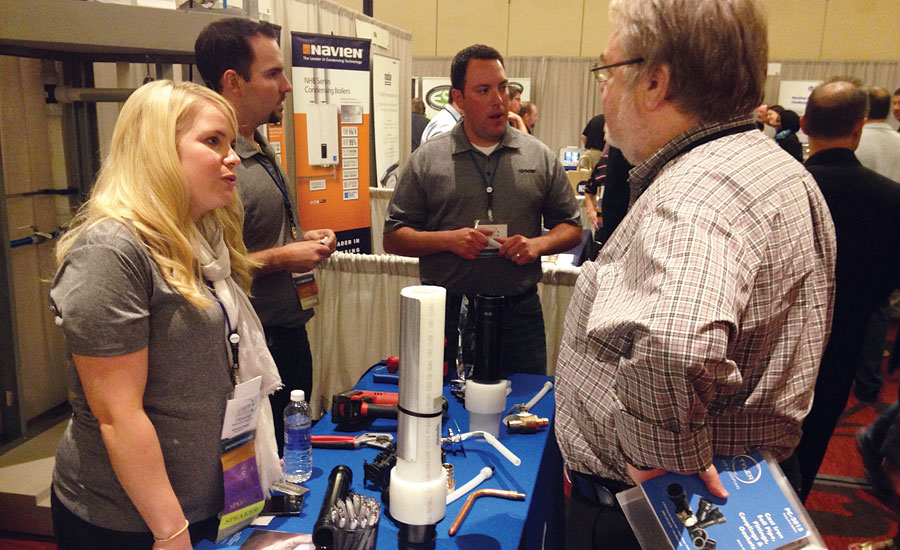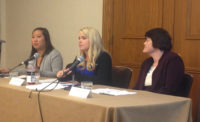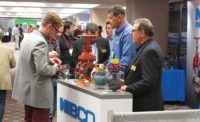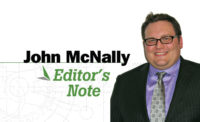More than 300 plumbing engineers, designers, manufacturers reps and industry professionals descended upon the Gateway to the West to partake in a bevy of training sessions, discussions and networking at the 2015 ASPE Technical Symposium.
The event – held Sept. 30-Oct. 4 at the Hyatt Regency at the Arch in St. Louis – kicked off with workshops and the Young Professionals Leadership Council meetings. On Oct. 1, more than 30 exhibitors filled two ballrooms for the Product Fair. Manufacturers such as Uponor, Viega, Victaulic, Zurn, Bradley Corp., Charlotte Pipe and Watts Water Technologies had high booth traffic during the three-hour evening event.
No new products were on display at the exhibitor booths, but the manufacturers appreciated having quality face-to-face with their clients. Vic Hines, certified plumbing designer, and senior field technical representative with Charlotte Pipe, said attending the Technical Symposium is a great time to connect with engineers.
He added Charlotte Pipe is continuing to stress value engineering to current and future engineering clients. “We’re giving them the tools to be successful (with their clients),” Hines said.
Friday and Saturday featured a full-court press of educational sessions and panel discussions. Friday was a marathon day with two blocks of three-hour sessions, not including the nearly two-hour lunch session that included roundtable discussions.
Sarah Balz, P.E., with Madison, Wis.-based Affiliated Engineers and pme’s 2014 Plumbing Engineer of the Year, was the presenter of the “LEED v4 In Depth” educational session. Balz provided about 100 people in attendance with the major changes from LEED v3 to v4, which will go into effect October 2016.
One key change Balz mentioned was how what once constituted a LEED Gold certification in v3 would now only meet LEED Silver in v4. “One goal was to increase the baseline from the previous version,” she noted.
Another element of LEED v4 engineers can use to their benefit deals with irrigation. If the design and installation of an irrigation system reduces water usage by 50%, that will count for one credit. If there is no irrigation system whatsoever, that will count for two credits.
There was a Friday afternoon panel discussion entitled “Ethics in Plumbing Engineering,” moderated by Uponor Business Development Manager for Engineering Services Devin Abellon, P.E. (For more thoughts on the panel discussion, please read this month’s Editor’s Note.)
The panel consisted of:
• Panelist – John Pritchard, a licensed plumber and member of the Plumbers Local #130 in Chicago;
• Panelist – Calina Ferraro, P.E., mechanical associate principal at Randall Lamb in San Diego;
• Panelist – Mike Rivers, a design services manager at Uponor North America; and
• Panelist – Michael Anders, senior project manager/estimator for B.E. Scaife.
With nearly 40 show attendees in the group, questions ranged from where to draw lines in industry relationships to best practices with handling ethical dilemmas. Abellon noted some of the common ethical issues engineers face deal with understanding their limits of expertise and protecting the public from the private client.
Anders, a contractor, stated to the group that “the economy has squeezed everyone and ethical decisionsare a fine line that we all have to walk.”
Ferraro added: “Ethics are a social framework. It’s the moral code.”
On Saturday, sessions were 75 minutes long and covered topics such as pipe hangers and supports, ASHRAE 90.1, medical gas design, fire pump testing, product certification and diversity in the industry.
Legionella was a major topic during the “Top Design Issues for Domestic Water Systems” educational session run by Raymond Parham, P.E., the lead engineer for plumbing/fire protection design at Nashville, Tenn.-based Phoenix Design Group.
Parham reminded the assembled engineers to have six to nine months between the building’s pressure tests and when the building is fully operational. “Engineers should require the contractor to do another flush out of the system before the building is operational because of water stagnation,” Parham said.
The late Saturday afternoon panel “The Diversity Factor in Plumbing: People, Not Fixtures” was presented by:
• Panelist – Lindy Damato, CPD, senior associate and plumbing/fire protection department head for WSP in its San Francisco office;
• Panelist – Stephanie Radel, CPD, design services supervisor for Uponor North America; and
• Panelist – Erin McConahey, P.E., a principal in mechanical engineering with global engineering firm Arup.
Each panelist told stories of how they have faced struggles in the workplace running the gamut of sexism, racism and more. Audience members chimed in and told their own stories as well.
The panel discussed “unconscious bias.” One example McConahey relayed to the group was from a 2004 report that showed in Turkey 27% of women enter the science, technology, engineering and mathematics fields. In the U.S., that number is only 10.2%.
“There is a lot of unconscious bias in the U.S. for women not to go into math and science,” McConahey said.
Other problems in offices include “micro inequities” such as when a woman makes a recommendation and it is ignored only for a man to make the same recommendation and see it adopted.
Frank Sanchez, CPD, with Evanston, Ill.-based Grumman/Butkus Associates, was part of the diversity panel and felt the discussion was long needed in the industry.
“I think the most important part of that seminar, which was a fantastic seminar, was the need for people to speak up,” he said.
Scott Thraen, a mechanical engineer with Omaha, Neb.-based Schnackel Engineers, attended his first ASPE Technical Symposium and enjoyed bonding with his fellow Young Professionals members. He also felt the importance of the group and his role in the industry during an educational session on Legionella.
“That just really hit home for me. My friends will joke with me and say, ‘Have fun learning about toilets,’” he said. “But 4,000 people die per year because of designs that are not optimum and do not kill the bacteria correctly. It’s not 100% our fault, but there is a lot that we can do to prevent that. That brings a lot of purpose to me.”
This article was originally titled “Meeting of the minds” in the November 2015 print edition of PM Engineer.




